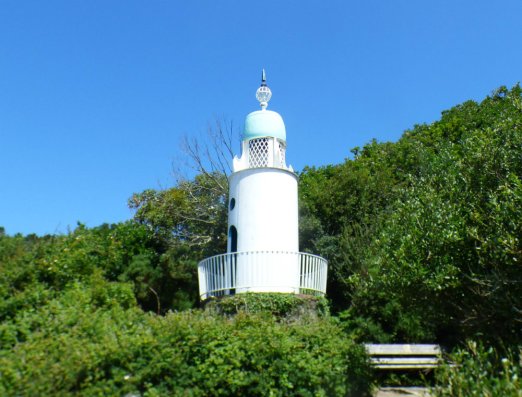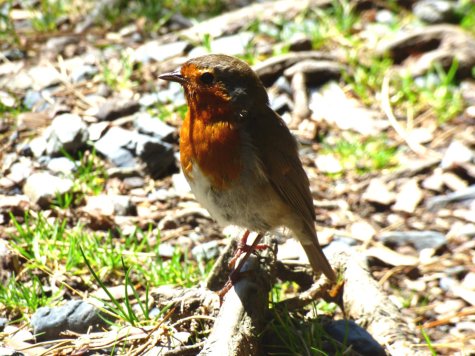
The heat was both welcome and unexpected. Britain in summer offers no guarantees, but on this, the Silent Eye’s third foray into Wales, we had once again been blessed with sunshine. Inevitably, at the earliest opportunity and armed with ice cream, we headed for the shade.

We had separated to go exploring and, as might be expected, Stuart and I had left the man-made landscape for the trees. We had spotted a small gazebo that promised superb views over the village and climbed the path into its relative comfort, feeling the contrast between light and shadow playing on our skin as we walked.

The landscape is not exactly natural. The old cove of Aber Iâ that is now known as Portmeirion, was once dominated by a Norman castle. Gerald of Wales mentions the newly built Castle of Deudraeth in 1188, and, although there is some debate about whether or not it was this castle, what is known is that the rocky outcrop does bear the remains fortifications and stonework dating back a thousand years. It was never a place of might, designed to withstand armies, but rather a symbolic demonstration in stone of lordly power. The castle was demolished in the 19th century and some of its stone was used in the building of Portmeirion. The main stretches of ancient wall that remain today are hidden within the rhododendrons, with only Clough Williams-Ellis’ fake battlements easily found. I rather like the idea that the old symbol of authority was used to create beauty and only a replica left behind.

A robin wandered over to see who we were and what possibilities we might offer, its wild heart free to choose its actions, within the limits of its nature. We relaxed, watching the world, until the silence was broken by the arrival of the land-train. For a few minutes, we saw the arm of authority exercise its power. As the train stopped, its occupants descended and, on instruction, made for our gazebo. They dutifully admired the view, each ceding place to another, and taking a quick photograph. The whistle blew and they all returned to the land-train, to be taken to the next place they would be told to admire. It was a small thing, a matter of minutes, but served to highlight the unconscious alacrity with which we human beings accept that our actions may be dictated.

Rejoining our companions, we headed once more for the relative cool of the woods, stopping to investigate the miniature lighthouse that rises from the trees. It is a tiny thing, made of metal and seems to serve no other purpose than to be there, adding its contrast to the green. You have to wonder if it works… or was ever meant to do so. It poses some odd questions. A lighthouse should be a beacon, yet, if it does not shine, if it is no more than an empty shell, is it still a vessel of light?

One of the wishing trees of Portmeirion was just around the next rise. There are a number of them; felled trees into which passers-by hammer coins with a stone. No-one seems to know why or when they began to appear. It reminded me of the old tree stump we had found outside a church, into which nails had been hammered, a relic harking back to an earlier time and belief. Once it was believed that witches could be kept at bay by hammering nails into trees. The coins, though, may be more of a votive offering. In folklore such gifts to the spirits of the trees and springs bring health or luck… and the removal of such coins reverses the gift. The number of coins is astonishing, even in the one small stump. Almost automatically, the urge to do likewise arises, even when the conscious mind has no such desire. It is as if remnants of a herd mind still linger, just below the surface, waiting for evolution to take its hands off the wheel.

A second robin joined us as we contemplated a contorted tree, hopping close to my outstretched hands…probably to see if they held lunch. He watched from a safe distance as we broke out of conformity for a while. The tree was too good not to climb, but too high to reach the lowest bough without a little ingenuity and teamwork. That is the other side of the ‘herd mind’; perched in the tree, we had achieved the improbable by working together.

We began to climb, leaving the sun for the shadows beneath the trees. The oriental gardens would be a perfect place to stop and share our readings. Oriental they may be, but our first sight of the water would have inspired Monet.
Continue reading at The Silent Eye










































Reblogged this on All About Writing and more.
LikeLike
Thanks, Henrietta 🙂
LikeLike
You are welcome!
LikeLiked by 1 person
Beautiful, all pic 🙂
LikeLike
Thank you 🙂
LikeLiked by 1 person
U have eye for a details..:)
LikeLiked by 1 person
Always a beautiful and reflective even mollifying read. With a few dabs of magic here and there.x
LikeLike
Thank you… though I would never have expected it to be pouring oil on troubled waters 🙂 x
LikeLike
Reblogged this on Die Erste Eslarner Zeitung – Aus und über Eslarn, sowie die bayerisch-tschechische Region!.
LikeLiked by 1 person
Thank you!
LikeLiked by 1 person
Wonderful images, a real wonderful landscape. Thx for sharing. 😉 Michael
LikeLike
It is a pleasure to share the jouney, Michael 🙂
LikeLiked by 1 person
Three robins, messengers, one and all. 🙂
LikeLike
The robins are always with us, wherever we go. 🙂
LikeLiked by 1 person